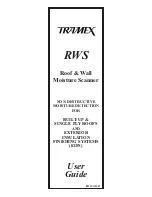
R.W.S.
User Guide
Fig 3. Laboratory Mock-Up
If you are not sure that you are starting over a dry area,
a pin type resistance meter such as the
Tramex Compact
or Professional
, with insulated deep wall probes may be
useful in confirming an acceptably dry area.
An alternative method is to use the
RWS
on a seek and
find basis as follows: Place the
RWS
against the sur-
face, adjust the sensitivity control knob so that the
meter reads, say 50. Then, by moving from area to area
and following in the direction of lowest reading until
the area of lowest reading is found (lowest reading
should indicate a relative dry area). Over this area, zero
the meter reading as described above. You can then
double check with a
Compact or a Professiona
l to con-
firm a dry area.
Having calibrated (zeroed) on a dry area, now proceed
with the moisture survey by moving the
RWS
across the
surface, making sure that electrodes are making full and
firm contact with the surface. Partial contact may result
in reduced readings.
Also ensure that you are holding the
RWS
firmly by its
handle as the
RWS
functions more efficiently when it is
hand held while in EIFS mode. If you are setting up a
grid pattern for your survey it is important to under-
stand that the
RWS
is reading the area directly below
the footprint of the instrument.
Interpretation of Readings
When the
RWS
has been zeroed correctly on a dry area
and set on the correct range for the EIFS thickness, a
higher than zero reading normally indicates higher
moisture content.
Summary of Contents for RWS
Page 18: ... R W S User Guide ...



















